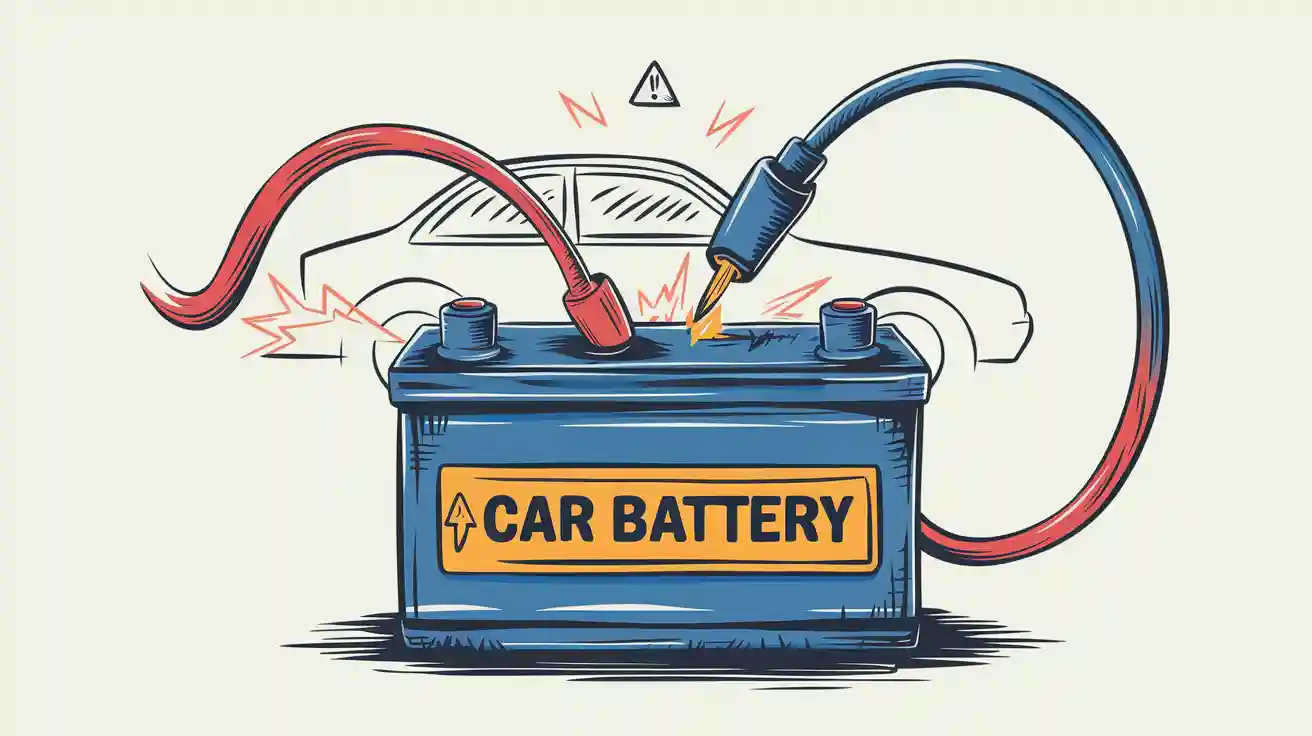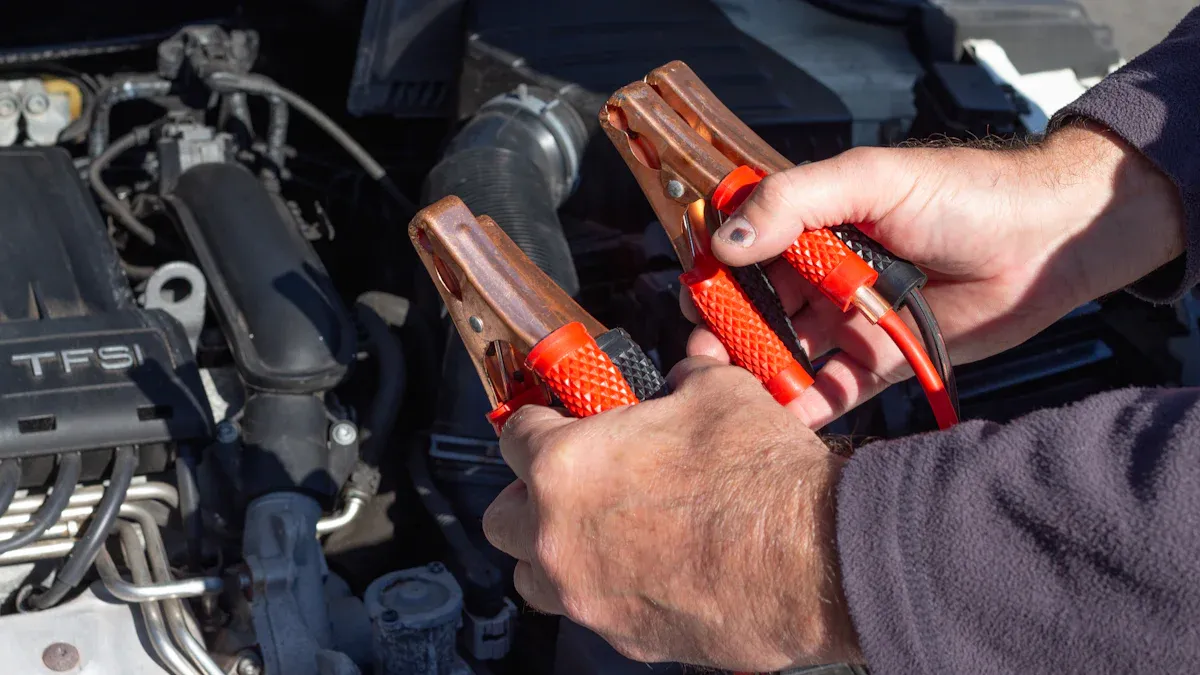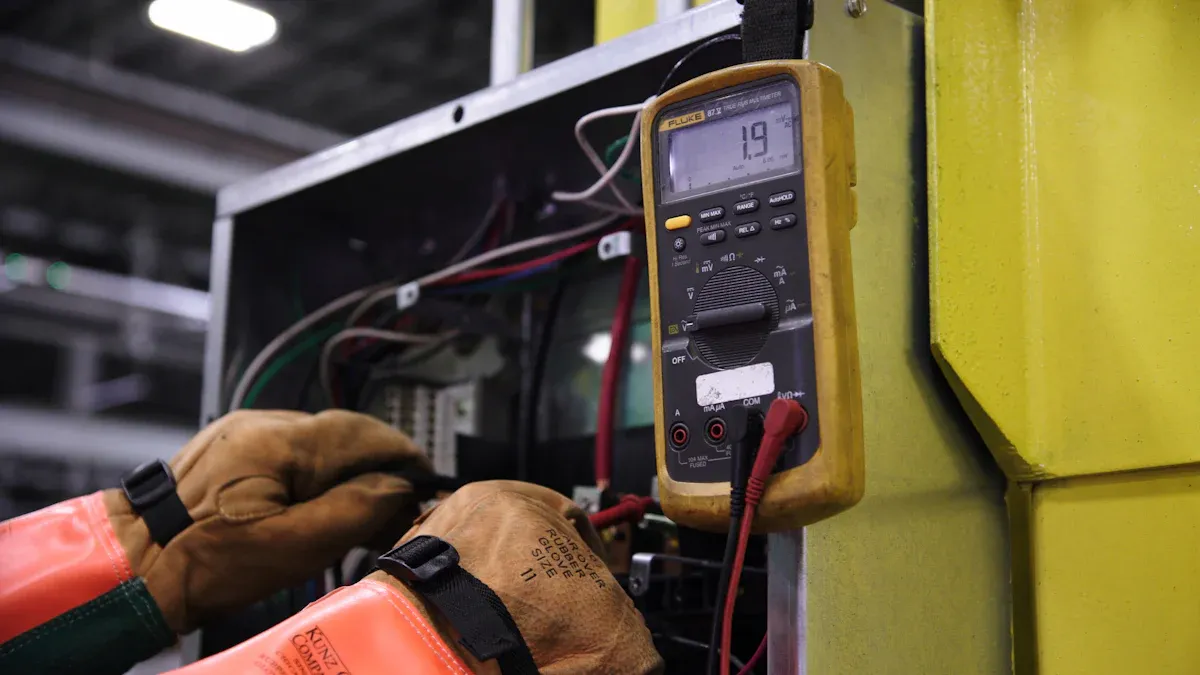
You face serious risks with battery terminal connection safety. If you connect the positive terminal and negative terminal incorrectly, reverse polarity can cause a short circuit, fire, or disrupt battery chemistry. Reverse polarity can damage battery terminals, chargers, and devices. Always check the positive terminal and negative terminal to prevent reverse polarity incidents. Battery terminal connection safety is critical. Reverse polarity poses hidden dangers. You must treat battery terminal connection safety as a top priority when handling lithium battery packs. Reverse polarity can threaten equipment, property, and your safety.
Key Takeaways
Always check and confirm battery terminal polarity before connecting to avoid dangerous reverse polarity mistakes.
Reverse polarity can cause serious damage to batteries, chargers, devices, and increase risks of fire and electrocution.
Use proper protective equipment, follow safety protocols, and train your team to prevent reverse polarity incidents and keep equipment safe.
Part 1: Battery Terminal Connection Safety

1.1 Why Polarity Matters
You must understand the fundamentals of battery terminal connection safety before working with lithium battery packs. Each pack has a positive terminal and a negative terminal, clearly marked with red and black colors or + and – symbols. These markings help you avoid mistakes when you connect positive to negative. In industrial environments, such as Medical, Robotics, Security System, Infrastructure, Consumer Electronics, and Industrial applications, the complexity of internal wiring increases the risk of error.
Lithium battery packs often use a Battery Management System (BMS) to balance charging and control current flow. If you reverse polarity, you risk a short circuit, overheating, or even fire. The effect of reverse polarity can damage the battery, disrupt the BMS, and threaten the safety of your equipment and personnel. Always consult manufacturer documentation and use a multimeter to confirm polarity before connecting any battery charger.
Tip: Wear insulated gloves and safety glasses when handling battery terminals. This reduces the risk of electrical shock and chemical exposure.
1.2 How Reverse Polarity Occurs
Reverse polarity can happen quickly in busy B2B or industrial settings. You might connect the positive terminal to the negative terminal by mistake, especially when working under time pressure or with complex battery packs. Human error, such as failing to double-check connections or using the wrong battery charger, remains a leading cause. Mismatched cells within a pack or a malfunctioning BMS can also cause current flow in the wrong direction, leading to the effect of reverse polarity.
Common mistakes include:
Connecting battery chargers with reversed leads
Not verifying polarity before connecting or disconnecting
Poor solder or crimp connections increasing resistance
Using thin wires that overheat
Ignoring corrosion on terminals
You must follow strict safety protocols and provide regular training to your team. This ensures battery terminal connection safety and reduces the risk of reverse polarity incidents. Regular inspection and using matched cells help maintain safe operation and extend battery life.
Part 2: Risks of Reverse Polarity

2.1 Damage the Battery
Reverse polarity presents immediate and long-term risks to lithium battery packs. When you connect terminals incorrectly, you expose the battery to hazardous conditions. You may notice overheating, swelling, smoke, or odor during charging. These signs indicate that you must stop charging immediately and observe the battery in a safe place. If you ignore these warnings, you can damage the battery and reduce its lifespan.
Repeated reverse polarity incidents in series-connected lithium iron phosphate (LiFePO4) battery systems can cause one cell to draw power from another. This leads to negative voltage readings and internal battery damage. You may see distortion, leakage, or shell damage, which can result in acid leaks and melted electronics. Over time, these failures degrade battery capacity and cause eventual system failure.
Battery Chemistry | Nominal Voltage (V) | Energy Density (Wh/kg) | Cycle Life (cycles) |
|---|---|---|---|
Lithium-ion | 3.6 | 150-250 | 500-1500 |
LiFePO4 | 3.2 | 90-160 | 2000-7000 |
Lithium-polymer | 3.7 | 100-200 | 300-1000 |
Solid-state | 3.7 | 250-400 | 1000-5000 |
You must use only designated battery charger models and verify polarity before every connection. If you work in medical, robotics, or infrastructure industries, you face higher risks due to complex wiring and large energy storage. Always inspect for corrosion and use matched cells to maintain safe operation.
Note: If you observe swelling, smoke, or odor during charging, terminate the process and move the battery to a safe area. Delayed chemical reactions may occur, so monitor the battery for several hours.
2.2 Damage the Charger
Reverse polarity can damage the charger and render it unusable. When you connect a battery charger with reversed leads, you risk failure of the bridge rectifier inside the charger. This component may produce no output or output AC voltage instead of DC, making the charger defective. In environments with transient reverse polarity events, such as USB hot-plugging or automotive power supplies, you may experience total electrical failure or even fire if the charger lacks proper protection.
Manufacturers design reverse polarity protection circuits using comparators and low-side FETs. These circuits detect incorrect battery insertion and block current flow, limiting surges to less than 50mA for under 200 nanoseconds. You benefit from this rapid switching, which protects both the battery charger and the battery. Some chargers use diodes, P-channel MOSFETs, or integrated protection ICs. Each method has advantages and disadvantages:
Protection Method | Implementation Details | Advantages | Disadvantages |
|---|---|---|---|
Diode Protection | Diode in series between battery positive and charger input. | Simple, low cost | Voltage drop reduces efficiency at high current. |
P-channel MOSFET Protection | MOSFET conducts only with correct polarity. | Low loss, high efficiency | Complex circuit, careful MOSFET selection needed. |
Integrated Protection IC | IC integrates MOSFET and control logic for direct use. | Reliable, supports multiple voltages | Higher cost, less suitable for low-budget designs. |
You must select battery charger models with robust reverse polarity protection, especially in industrial settings. Always verify connector orientation and use appropriate tools to avoid damaging the charger.
2.3 Device and Equipment Risks
Reverse polarity can cause widespread device and equipment failures. You may encounter blown fuses, damaged vehicle computers (PCM, BCM, ABS), and harm to electrical system components. Audio systems and electronic control units (ECUs) are especially vulnerable. A surge of current can cause short circuits, sparks, and burned wiring insulation. Starter motor insulation may burn, reducing its lifespan.
Industrial equipment, such as motor controllers and medical devices, often rely on diodes and fuses for protection. If PCB traces are undersized, reverse polarity can vaporize these traces, requiring costly repairs. In documented cases, reverse polarity bypassed safety mechanisms, causing energized appliance casings and shock hazards. You must ensure that all devices include reverse polarity protection circuits and that battery charger connections are correct.
Tip: Use XT60 connectors with anti-reverse polarity construction. These connectors prevent incorrect connections and reduce the risk of short circuits.
2.4 Fire and Electrocution Hazards
Reverse polarity increases the risk of electrical fire and electrocution. When you connect a lithium battery pack with reversed polarity under load, one cell may be forced to charge improperly. This can cause rapid overcharging, leakage, explosion, or fire. Excessive discharge current through other cells leads to overheating and failure. Thermal runaway may result in venting of hot gases or projectiles, increasing fire risk.
You must use terminal structures and keyed connectors to prevent reverse polarity installation. Integrated reverse polarity protection circuits and proper housing design help vent gases and prevent thermal runaway propagation. Always keep battery packs away from heat sources and allow for expansion in battery compartments.
Risk Factor | Description |
|---|---|
Overcharging | Improper charging causes cell leakage, explosion, or fire. |
Thermal Runaway | Rapid temperature increase leads to venting of hot gases or projectiles. |
Fire Propagation | Poor housing design allows fire to spread to nearby equipment. |
Electrocution | Energized casings and bypassed safety mechanisms present shock hazards. |
You must follow strict safety protocols and provide regular training to your team. Use diodes, MOSFETs, reverse polarity protection ICs, and fuses to safeguard battery systems. Always double-check connections before powering up any battery charger.
Reverse polarity can cause immediate equipment failure and long-term battery degradation, especially in lithium battery packs used in medical, robotics, and infrastructure industries. You improve safety by following these steps:
Turn off all power sources before connecting.
Identify terminals and confirm polarity.
Inspect connections regularly.
Always double-check before powering up to protect your assets and team.
FAQ
What should you do if you connect battery terminals backwards in a Medical device?
You must disconnect power immediately. Inspect for damage. Contact Large Power for expert support. Review medical battery solutions for safe practices.
How does reverse polarity affect lithium-ion, LiFePO4, lithium-polymer, and solid-state battery packs?
Chemistry | Voltage (V) | Energy Density (Wh/kg) | Cycle Life (cycles) |
|---|---|---|---|
Lithium-ion | 3.6 | 150-250 | 500-1500 |
LiFePO4 | 3.2 | 90-160 | 2000-7000 |
Lithium-polymer | 3.7 | 100-200 | 300-1000 |
Solid-state | 3.7 | 250-400 | 1000-5000 |
Reverse polarity can cause overheating, capacity loss, or fire in all chemistries. Learn more about lithium-ion, LiFePO4, lithium-polymer, and solid-state battery packs.
Where can you get custom consultation for industrial lithium battery pack safety?
You can request a custom battery consultation from Large Power for industrial, robotics, security, infrastructure, and consumer electronics battery safety solutions.




